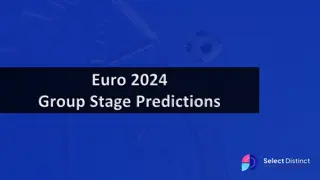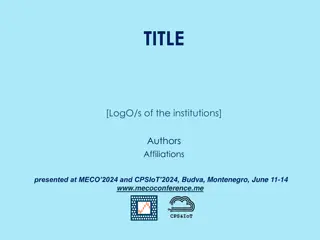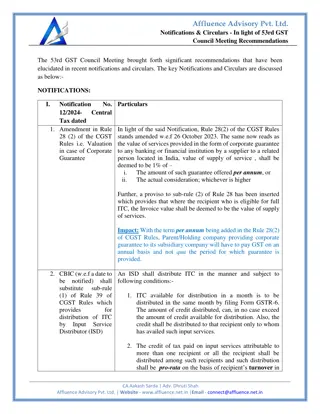
Color Coding Algorithms in Advanced Topics on Algorithms
Explore color coding algorithms in advanced topics on algorithms, including parameterized algorithms, bounded-search trees, kernelization, and more. Learn about solving NP-hard problems like k-Path and boosting the probability of success through independent repetitions.
Download Presentation

Please find below an Image/Link to download the presentation.
The content on the website is provided AS IS for your information and personal use only. It may not be sold, licensed, or shared on other websites without obtaining consent from the author. If you encounter any issues during the download, it is possible that the publisher has removed the file from their server.
You are allowed to download the files provided on this website for personal or commercial use, subject to the condition that they are used lawfully. All files are the property of their respective owners.
The content on the website is provided AS IS for your information and personal use only. It may not be sold, licensed, or shared on other websites without obtaining consent from the author.
E N D
Presentation Transcript
Advanced topics on Algorithms Luciano Gual www.mat.uniroma2.it/~guala/
Parameterized algorithms Episode II
Toolbox (to show a problem is FPT) bounded-search trees color coding kernelization algebraic techniques iterative compression treewidth
k-Path Input: - - a graph G=(V,E) a nonnegative integer k question: is there a simple path of k vertices parameter: k obs: NP-hard since it contains the Hamiltonian path as special case Theorem [Alon, Yuster, Zwick 1994] k-Path can be solved in time 2O(k)nO(1). previous best algorithms had running time kO(k)nO(1).
color coding - assign colors from {1,...,k} to vertices V(G) uniformly and independently at random.
color coding - assign colors from {1,...,k} to vertices V(G) uniformly and independently at random. 5 4 4 4 2 2 3 3 2 1 - check if there is a path colored 1-2-...-k and output YES or NO
color coding - assign colors from {1,...,k} to vertices V(G) uniformly and independently at random. 5 4 4 4 2 2 3 3 2 1 - check if there is a path colored 1-2-...-k and output YES or NO obs1: if there is no k-path: no path colored 1-2-...-k exists NO obs2: if there is a k-path: there is some probability that this path is colored 1-2-...-k k-k. YES with probability k-k. probability of success:
boosting the probability of success: independent repetitions Useful fact If the probability of success is at least p, then the probability that the algorithm does not say YES after 1/p repetitions is at most 1/p (1-p)1/p (e-p) = 1/e 0.38 - Thus, if p k-kthen error probability is at most 1/e after kk repetitions - repeating the whole algorithm a constant number of times can make the error probability an arbitrary small constant example: trying 100 kkrandom colorings, the probability of a wrong answer is at most (1/e)100.
Finding a path colored 1-2-...-k 3 4 1 2 5 3 4 1 2 5 3 4 1 2 5 3 4 1 2 5 - edges connecting nonadjacent color classes are removed - the remaining edges are directed towards the larger class - all we need to check if there is a directed path from class 1 to class k
Finding a path colored 1-2-...-k 3 4 1 2 5 3 4 1 2 5 3 4 1 2 5 3 4 1 2 5 - edges connecting nonadjacent color classes are removed - the remaining edges are directed towards the larger class - all we need to check if there is a directed path from class 1 to class k
Finding a path colored 1-2-...-k 3 4 1 2 5 3 4 1 2 5 3 4 1 2 5 3 4 1 2 5 - edges connecting nonadjacent color classes are removed - the remaining edges are directed towards the larger class - all we need to check if there is a directed path from class 1 to class k
Finding a path colored 1-2-...-k 3 4 1 2 5 3 4 1 2 5 3 4 1 2 5 3 4 1 2 5 - edges connecting nonadjacent color classes are removed - the remaining edges are directed towards the larger class - all we need to check if there is a directed path from class 1 to class k
Finding a path colored 1-2-...-k 3 4 1 2 5 3 4 1 2 5 3 4 1 2 5 3 4 1 2 5 - edges connecting nonadjacent color classes are removed - the remaining edges are directed towards the larger class - all we need to check if there is a directed path from class 1 to class k
color coding color coding success probability k-k finding a 1-...-k colored path k-Path polynomial time solvable
improved color coding - assign colors from {1,...,k} to vertices V(G) uniformly and independently at random. 5 4 4 4 2 2 3 3 2 1 - check if there is a colorful path (each color appears exactly once) and output YES or NO obs1: if there is no k-path: no colorful path exists NO obs2: if there is a k-path: there is some probability that it is colorful probability of success: k! kn-k = (k/e)k k! e-k = YES with probability e-k. kn kk kk
improved color coding - assign colors from {1,...,k} to vertices V(G) uniformly and independently at random. 5 4 4 4 2 2 3 3 2 1 - repeating the algorithm 100 ektimes, the probability of a wrong answer is at most (1/e)100. how to find a colorful path? k! nO(1)time - try all permutations: - dynamic programming: 2k nO(1)time
finding a colorful path subproblems: v V, non-empty subset S {1,...,k} Path(v,S): is there a path P ending at v such that each color of S appears in P exactly once and no other color appears in P? obs1: There is a colorful path iff Path(v,{1,...,k})=TRUE for some v obs2: # of subproblems 2k n
finding a colorful path subproblems: v V, non-empty subset S {1,...,k} Path(v,S): is there a path P ending at v such that each color of S appears in P exactly once and no other color appears in P? |S|=1 (base case) Path(v,S)=TRUE iff S={col(v)} |S| 1 if col(v) S OR Path(u,S-{col(v)}) (u,v) E Path(v,S)= FALSE otherwise u v
color coding color coding success probability e-k finding a colorful path k-Path solvable in 2k nO(1)time Theorem There is a randomized algorithm for k-Path that runs in time (e2)knO(1) that either reports a failure or find a path of k vertices. Moreover, the algorithm finds a solution of a YES-instance with constant probability.
Kernelization a 2k-vertex kernel for VC based on linear programming
an Integer Linear Programming (ILP) formulation of VC LP-relaxation minimize minimize xv xv v V v V e=(u,v) E e=(u,v) E xu +xv 1 xu +xv 1 subject to subject to v V xv 0 v V xv {0,1} relax with a feasible solution is a fractional VC xv 0 & xv 1 OPTf: cost of the min fractional VC redundant OPTf OPT
Let x be an optimal fractional solution. V0 = { v V : xv } V0.5 = { v V : xv= } V1 = { v V : xv } Theorem (Nemhauser-Trotter) There is a minimum vertex cover S of G such that V1 S V1 V0.5
proof Let S=(S*\V0) V1 Let S* be a minimum VC S is a VC claim: S is minimum since every adjacent vertex of V0must be in V1 assume by contradiction that |S|>|S*| |S* V0| |V1\S*| V0.5 V1 V0 - A B xv- xv+ xv A if v A if v B otherwise + yv = B S* = min{|xv- | : v V0 V1} claim: - y is strictly better that x - y is feasible v u A contradicts optimality of x - interesting case: u or v A since S* is a VC then u B or u S*\B u v A - u v A - +
kernelization compute an optimal fractional solution x of the LP-relaxation for the VC instance (G,k). Define V0,V0.5, V1as before. if conclude that (G,k) is a No-instance. v V xv k Otherwise, greedily pick V1in the VC, delete vertices in V1and V0 (and all their incident edges). The new instance is (G =G-(V1 V0),k =k-|V1|). Theorem k-Vertex Cover admits a kernel of at most 2k vertices. proof (G,k) is a YES-instance iff (G ,k ) is a YES-instance |V(G )| = |V0.5 | = v V0.5 2xv 2 xv 2k v V
The party problem problem: maximize: total fun factor of the invited people invite people to a party constraint: everyone should be having fun do not invite a colleague and his direct boss at the same time! 2 a tree with weights on the nodes input: 7 6 goal: an independent set of maximum total weight 3 1 3 2 3
The party problem problem: maximize: total fun factor of the invited people invite people to a party constraint: everyone should be having fun do not invite a colleague and his direct boss at the same time! 2 a tree with weights on the nodes input: 7 6 goal: an independent set of maximum total weight 3 1 3 2 3 Exercise: give a polynomial time algorithm for it OPT= 15






















